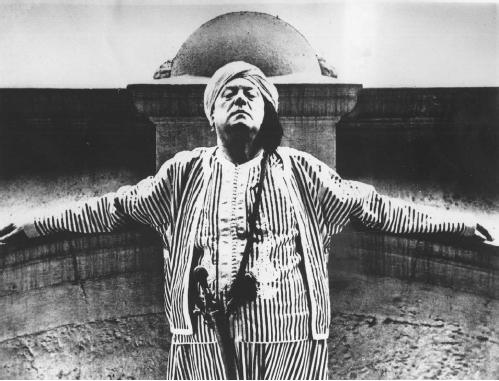Magi
Aleister crowley (1875–1947)
Aleister Crowley (Edward Alexander Crowley) is one of the most controversial figures in the annals of modern occultism. Along with the Freudians, Crowley believed that most of humankind's ills were caused by inhibition of the sexual impulses. Consequently, much of Crowley's magick drew its impetus from the release of psychic energy through sexual activity, including homosexuality and other practices that earned for Crowley the distinction of being named one of the most sinister figures of modern times. In his day, and for some time
afterward, the name of Aleister Crowley was almost synonymous with evil. Crowley's own mother, a fundamentalist Christian, dubbed him "The Great Beast 666," a diabolical image drawn from the Book of Revelation.
In Cairo, Egypt, in 1904 a being that called itself "Aiwass" suddenly took possession of Crowley's wife after she had uttered something to the effect that "they" wished to communicate with him. At the time, they were standing before the Stele of Revealing in the Cairo Museum. There followed three days of dictation by Aiwass to Crowley. The text of this dictation forms The Book of the Law (1904), which was supposed to herald the coming of the Age of Horus, the child.
Crowley won the distinction of being the "wickedest man in the world" while he was conducting an institution he called the Sacred Abbey of Thelema. Located on the island of Sicily, the abbey was dedicated to the practice of magic, uninhibited sex accompanied by liberal use of drugs, and worship of ancient Gnostic deities. Ritual intercourse, both hetero and homosexual in nature, was the chief form of worship.
Drawing upon ancient Gnostic magical texts, Crowley added to an old Graeco-Egyptian text and performed the rite of Liber samekh, celebrating sexual release and the passage of the spirit from a lower level of consciousness to a higher one. Crowley added his own contributions to the original Gnostic text, some of which were "High Supernatural Black Magic" and "Intercourse with the Demon." According to Crowley the ritual was the one to be employed by the Beast 666 for the attainment of knowledge and conversation with his holy guardian angel. In The Black Arts (1968) Richard Cavendish comments on the Liber samekh: "To know the angel and have intercourse with the demon . . . means to summon up and liberate the forces of the magician's unconscious. The performance of the ritual is accompanied by…the mounting frenzy with which the barbarous names of power are chanted…ending in a climax which is both physical and psychological and in which the magician's innermost powers are unleashed."

Crowley's life and career are illustrations of the two possibilities inherent in experimenting with altered states of consciousness. Whatever else might be said about him, Crowley was a powerful magician and a master of the art of ritual. Crowley's excesses and eventual decline probably were results of his reliance upon narcotics. His philosophy of life was summed up in an analysis by journalist Tom Driberg in the days when Crowley was beginning to be called the wickedest man in the world: "His basic commandment was 'Do what thou wilt.' Since his training in serious, formal magick (as he spelt it) was rigorous, he did not mean by this 'Follow each casual impulse.' He meant 'Discover your own true will and do it.' In other words, 'Know yourself and be yourself.'"
Before his death Crowley was rumored to have started a group on the American West Coast that included the study and practice of alchemy. The deaths of several persons as the results of mysterious explosions were connected with this practice; but if a Crowley cult ever existed, it had all but vanished within a few years after his death.

Comment about this article, ask questions, or add new information about this topic: